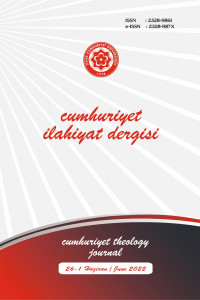Türk Din Mûsikîsinde Nevbe Formu ve Keyyâlîyye Tarîkindeki İcrasının İncelenmesi
The Nawba in Turkish Religious Music and Its Tariq of Kayyali Performance Examination
Author(s): Safiye Şeyda ErdaşSubject(s): Music, Theology and Religion, Islam studies, Sociology of Art
Published by: Cumhuriyet Üniversitesi İlahyat Fakültesi
Keywords: Turkish Religious Music; Lodge Music; Hymns; Nawba; Kayali; Rifai;
Summary/Abstract: Music is an art that maintains its existence with people and is shaped by them. Especially social needs and rituals determine the place and structure of music in social life. Accordingly, some forms change and develop over time, while others remain dormant and disappear. In addition to the changes in the needs and rituals of the society regarding music, the fact that knowledgeable people could not transfer their knowledge and experience to the next generations is also an important factor in this change. The musical accumulation, which could not be recorded or transferred, becomes known only with a theoretical expression after a while. In the sources, it is reported that nawba was performed especially at holy nights and at weddings or funeral ceremonies and even in the “processions of amen”. The information about how the nawba is performed and the text of the “salawats” and “nawba” sermons recited have survived to the present day with the help of lyric corpus. Additionally, people who witnessed the last years of the Ottoman Empire and the first years of the Turkish Republic, report the places, times and purposes of these sermons. The “shuguls” recited during the Nawba performance spread to Anatolia and the Balkan lands by the sects of Arab origin. This shows us that nawba was practiced in a very wide geography in the past. When it comes to today, it is seen that nawba is still practiced in geographies where we are in the same cultural basin. The subject of our study is an example of nawba performed by the members of the Kayyali order, which was recorded in 2017. This lodge music form, which has been performed in Idlib and Aleppo regions for centuries, is also decorated with the musical taste of the region. Some muwashshah types, which have an important place in the culture and music of Aleppo, are included in the nawba performance. The Kayyali sect emerged with Shaykh Ismail al-Maczum al-Kayyali (died 685/1286) in the village of Tronbe, which is connected to today's Idlib. After the death of Shaykh Ismail al-Maczum al-Kayyali, who was also Ahmed Rifai's grandson and grew up in the Rifai hearth, the Kayyali sect spread among his descendants and followers. The Kayyali sect, which is classified as a branch of Rifai, is among the sects that make dhikr while standing. Many practices such as dhikr of qiyam, Demdeme, which we know to be performed in the late period Istanbul sufi culture and lodge music, are among the rites of the Kayyali sect. The members of the Kayyali family, who continued to practice the Kayyali method and manners in and around Aleppo until recently, had to immigrate to Turkey in 2013 due to the political turmoil and difficult living conditions in the region. Here, they are trying to transfer their culture and knowledge to the next generations. With his personal efforts, Hasan Sevil recorded a performance performed by the members of the Keyyali sect in Ayyub Sultan, Istanbul in 2017. This ceremony, which was performed with the participation of 14 people, was administered by Shaykh Muhammed Bakir al-Kayyali and his brother Shaykh Hasan al-Kayyali, the shaykhs of Idlib, Bab al-Hadid Keyyâlî Lodge. Registration takes approximately one hour. This nawba, which is performed in four chapters together with the dhikr of qiyam, overlaps with the information that has survived to the present day in many respects. The study bases on literature review and some examples of nawba sermons have emerged for the first time with this study. The main lines of the nawba and the flow of execution are discussed through the mentioned record. In addition, the reasons why the nawba was performed and the namings related to it are given. Here, too, practices such as the nawba performance performed in funeral ceremonies have been encountered. The parts of nawba in performance are explained in order and sample texts are given. Some examples of nashida and hymns were notated and presented in the study in terms of being an example and giving an idea about nawba music. Although the Kayyali family, who performs the nawba, has a large population in the world, it is not well known especially in Turkey and there is no particular study on this subject. On the occasion of this study, new information has been given, albeit briefly, about the life of İsmail el-Maczum el-Kayyalı, the founder of the Kayyalı sect, and the Kayyali sect.
Journal: Cumhuriyet İlahiyat Dergisi
- Issue Year: 26/2022
- Issue No: 1
- Page Range: 101-120
- Page Count: 20
- Language: Turkish

